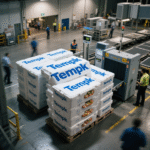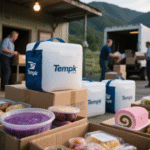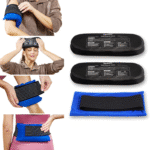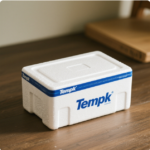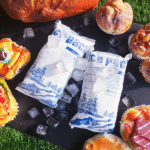How Pharma Cold Chain Logistics Companies Drive Safe Delivery of Biologics
Introduction: When you need temperature sensitive vaccines and biologics to arrive potent, pharma cold chain logistics companies make it happen. These specialist carriers manage storage, packaging and transport within strict temperature ranges so the medicine you receive stays safe. In 2024 the pharmaceutical cold chain logistics market reached US$18.61 billion and is projected to exceed US$27 billion by 2033. Recent reports forecast the broader healthcare cold chain logistics industry at US$65.14 billion in 2025 and US$137.13 billion by 2034, growing at 8.63 % annually. This article explores key players, innovations and trends so you can choose the right partner and understand how the industry is evolving.

Which pharma cold chain logistics companies lead the market and what services do they offer?
How big is the pharmaceutical cold chain logistics market and where is it growing fastest?
What technologies and packaging innovations are transforming temperature controlled logistics?
What challenges and opportunities define the supply chain for biologics and vaccines?
What is the pharma cold chain and why does it matter?
Direct answer: Pharma cold chain logistics companies specialise in the storage and transportation of temperature sensitive products, including vaccines, biologics and gene therapies. They use refrigerated warehouses, insulated containers, temperature controlled vehicles and real time monitoring to ensure medicines remain within strict temperature bands—typically 2 °C to 8 °C or even cryogenic conditions below −150 °C—to prevent degradation. With biologics now accounting for roughly 30 % of all drugs, maintaining a reliable cold chain is critical to patient safety and regulatory compliance.
Expanded explanation: Think of the cold chain as a relay race where each runner must carry a baton (your medicine) without letting it warm up or freeze. Pharma cold chain logistics companies manage this relay from manufacturing to patient delivery, coordinating storage, transportation, packaging and monitoring. They track temperature, humidity and location in real time via IoT sensors and digital control towers so that deviations are spotted immediately. Cold chain compliance also involves adhering to regional regulations and Good Distribution Practice (GDP) standards. Companies invest in training, standardized procedures and validated equipment to meet these requirements. Without this meticulous infrastructure, sensitive biologics like vaccines and insulin would lose potency, putting public health at risk.
Key elements of a pharmaceutical cold chain
| Element | Purpose | Practical significance |
| Temperature controlled storage | Refrigerated warehouses, cryogenic freezers and insulated rooms hold products at 2 °C–8 °C, –20 °C or –150 °C | Maintains drug efficacy and safety during inventory periods |
| Insulated packaging | Single use and reusable shippers with phase change materials protect shipments during transit | Prevents temperature excursions and enables last mile delivery even at −70 °C |
| Real time monitoring | IoT sensors, RFID tags and cloud platforms record temperature, humidity and location continuously | Provides early alerts to prevent spoilage; 80 % of cold chain pharma shipments use real time monitoring |
| Logistics coordination | Route planning, customs clearance and documentation ensure timely delivery | Minimises delays that could compromise product integrity; essential for global supply chains |
| Regulatory compliance | GDP standards, ISO certifications and local regulations guide equipment and processes | Reduces legal risk and ensures quality across regions |
Practical tips for choosing cold chain services
Define your temperature profile: Determine whether your products need refrigerated (2–8 °C), frozen (below −20 °C) or cryogenic (<−150 °C) transport. Select a provider with equipment certified for that range.
Ask about monitoring: Choose companies offering real time temperature and location tracking. IoT enabled control towers can prevent product loss and improve visibility.
Confirm GDP compliance: Ensure providers hold relevant certifications (e.g., ISO 9001, GDP). This demonstrates standardised processes and quality control.
Consider sustainability: Reusable packaging and energy efficient vehicles reduce waste and may lower costs.
Plan for global reach: If you ship internationally, work with providers experienced in customs documentation and multiple transportation modes.
Real example: In February 2024 Sensitech launched TempTale GEO X, an IoT enabled temperature monitor tailored for life sciences logistics. The device allows real time analytics across air, ocean, road and rail shipments, enabling early interventions when deviations occur. Such innovations show how technology enhances cold chain visibility and compliance.
How large is the pharmaceutical cold chain logistics market?
Direct answer: The pharmaceutical cold chain logistics market was valued at US$18.61 billion in 2024 and is forecast to reach US$27.11 billion by 2033 at a compound annual growth rate (CAGR) of 4.3 %. The wider healthcare cold chain logistics industry—including medical devices and blood products—was estimated at US$59.97 billion in 2024, grew to US$65.14 billion in 2025 and is projected to hit US$137.13 billion by 2034 with an 8.63 % CAGR. Growth is driven by rising demand for biologics and vaccines, stricter regulatory standards and investment in advanced monitoring and packaging.
Expanded explanation: The cold chain’s steady expansion reflects both the growing pipeline of temperature sensitive therapies and the globalisation of pharmaceutical supply. Biopharmaceuticals dominate revenue because monoclonal antibodies, cell and gene therapies and mRNA vaccines must remain within tight temperature ranges to retain efficacy. Simultaneously, governments are investing in public health infrastructure; for example, India’s pharma cold chain logistics segment is projected to grow at 3.2 % annually and reach US$0.8 billion by 2033, while Europe’s market is expected to rise from US$21.55 billion in 2025 to US$34.70 billion in 2030 at roughly 10 % CAGR. Asia Pacific is the fastest growing region due to vaccine distribution programmes and expanding biologics manufacturing.
Regional market snapshot
| Region | 2024/25 market size | Forecast growth & drivers | Practical implications |
| Europe | ~US$19.39 billion in 2024 increasing to US$21.55 billion in 2025 | ~10 % CAGR expected to reach US$34.7 billion by 2030; high demand for ultra cold storage due to biologics and gene therapies | Providers must invest in cryogenic capacity and comply with strict EU GDP regulations |
| North America | Backbone of global cold chain | Investments by UPS, DHL and other integrators expand capacity; dominated by U.S. biologics and vaccine shipments | Emphasis on end to end logistics solutions and integration with clinical trials |
| India | US$0.57 billion in 2024 | 3.2 % CAGR to reach US$0.8 billion by 2033; government initiatives like the National Cold Chain Management Information System encourage investment | Opportunity for last mile distribution improvements and local partnerships |
| Asia Pacific | Fastest growth region | Driven by vaccine distribution and biologics manufacturing; key players include DHL & Lineage | Rising infrastructure development and adoption of reusable packaging |
Market dynamics and segmentation
The sector is typically segmented by product type (vaccines, biopharmaceuticals, drugs), service type (storage, transportation, packaging), temperature range (refrigerated, frozen, ambient, cryogenic) and mode of delivery (last mile vs hubs to distributor). According to DataM Intelligence, these segments help companies tailor solutions and forecast demand. For example, the biopharmaceuticals segment generated the largest revenue in 2024, while the vaccines segment is expected to grow fastest due to ongoing immunisation campaigns. Among services, storage currently accounts for the largest share, but transportation is projected to grow fastest as real time monitoring technologies reduce transit risk.
Leading pharma cold chain logistics companies in 2025
Direct answer: Leading pharma cold chain logistics companies include integrators, freight forwarders, packaging specialists and equipment manufacturers. Major logistics providers comprise UPS Healthcare, DHL Life Sciences & Healthcare, FedEx, AmerisourceBergen, Cardinal Health, Kuehne+Nagel, CEVA Logistics and VersaCold. Packaging and equipment innovators include Cold Chain Technologies (CCT), C Safe Global, Pelican BioThermal, Envirotainer, Thermo Fisher Scientific, Azenta, Summit Appliance and DS Smith. These firms provide temperature controlled transport, insulated shippers, reusable packaging, cryogenic storage and digital monitoring solutions.
Expanded explanation: The pharmaceutical cold chain ecosystem consists of several types of companies:
1. Third party logistics (3PL) and integrators
These firms manage end to end transportation and warehousing. They invest heavily in fleet capacity, acquisitions and digital platforms.
UPS Healthcare has expanded its cold chain capabilities through acquisitions. In 2025 it acquired Germany’s Frigo Trans and BPL, adding Pan European temperature controlled warehousing and time critical freight forwarding. UPS invested more than €20 million in 2024 to add over 200 temperature controlled vehicles, doubling its global healthcare compliant distribution space to 1.7 million m². It also agreed to buy Canada’s Andlauer Healthcare Group for US$1.6 billion in April 2025, adding nine distribution centres and 22 branches.
DHL Life Sciences & Healthcare acquired CryoPDP in March 2025 to integrate temperature sensitive shipping, storage and packaging and strengthen its U.S. presence. DHL operates a global network of over 150 healthcare logistics facilities and emphasises sustainable packaging and alternative fuels.
FedEx continues to expand cold chain capacity through FedEx Express and Custom Critical units, providing temperature controlled air cargo and ground services. FedEx invests in IoT sensors and blockchain traceability.
CEVA Logistics and Kuehne+Nagel offer specialised pharmaceutical logistics services, including GDP compliant warehouses, packaging and last mile delivery. They partner with airlines and biotech firms to ensure global reach.
VersaCold (Canada) and Lineage Logistics (U.S.) operate extensive cold storage networks. Lineage integrates warehouse robotics and smart software to optimise energy consumption and maintain temperature integrity. VersaCold focuses on end to end supply chain solutions for food and pharmaceuticals and is expanding across North America and Asia.
AmerisourceBergen and Cardinal Health provide pharmaceutical distribution services and cold chain packaging through subsidiary Sonoco ThermoSafe. They deliver high volume shipments to hospitals and pharmacies and manage real time monitoring systems.
2. Packaging and equipment specialists
These companies develop insulated shippers, reusable containers and storage equipment to protect pharmaceuticals.
Cold Chain Technologies (CCT) supplies reusable pallet shippers and the CCT Tower Elite system, launched at LogiPharma 2025. The company also rolled out a temperature controlled pallet shipper in April 2025 and is known for reusable packaging that reduces waste.
C Safe Global manufactures active container systems with controlled heating and cooling for air and ground transport. Its containers maintain 2 °C–8 °C and 15 °C–25 °C ranges for up to 120 hours.
Pelican BioThermal offers Credo Cube reusable shippers and single use CoolPall boxes. Its containers include integrated data loggers for temperature tracking.
Envirotainer provides active air cargo containers using compressor driven cooling and battery power to maintain stable temperatures. UPS executives cite Envirotainer as essential for last mile delivery at −70 °C.
DS Smith debuted , a fibre based packaging solution providing up to 36 hours of thermal stability, at Pharmapack Europe 2025. The use of fibre reduces plastic waste and enhances recyclability.
Summit Appliance, Philipp Kirsch and Binder produce medical refrigerators, ultra low temperature freezers and climate chambers, enabling laboratory and clinical storage. German manufacturer Binder’s freezers operate from −40 °C to −90 °C and include password protection and alarm systems.
Azenta (formerly Brooks Automation) expanded its cold chain capabilities by acquiring B Medical Systems, offering automated storage and cryogenic transport solutions. The company also provides genomic sequencing services and sample tracking software.
Thermo Fisher Scientific supplies laboratory refrigerators, freezers and cryogenic dewars. In April 2024, CSafe (a Thermo Fisher subsidiary) introduced Multi Use Dewars with real time tracking, enabling cell and gene therapies to be transported at –150 °C.
3. Technology and monitoring providers
Sensitech offers IoT devices like TempTale GEO X for real time temperature monitoring across multiple transport modes.
TransVoyant provides AI powered supply chain tracking systems that create digital twins and predict disruptions.
CargoSense uses AI to predict shipment issues before departure.
Tag N Trac develops Bluetooth and cellular trackers for real time visibility and intelligent labelling.
How leading companies differentiate
| Company | Core services | Differentiators | Practical benefit |
| UPS Healthcare | Global cold chain transport, warehousing, supply chain integration | Aggressive acquisitions (Frigo Trans, BPL, Andlauer), fleet expansion, end to end visibility | Broader network and cryogenic capacity; reduced product loss via integrated monitoring |
| DHL Life Sciences & Healthcare | Temperature controlled air and ground transport, storage, packaging | Acquisition of CryoPDP; focus on sustainable packaging and alternative fuels | Enhanced service range and environmental compliance |
| Cardinal Health & AmerisourceBergen | Pharmaceutical distribution, packaging | 3PL services, specialised packaging (Sonoco ThermoSafe), broad pharmacy network | Reliable distribution to hospitals and pharmacies; real time monitoring |
| Lineage & VersaCold | Cold storage and logistics | Facility networks with warehouse robotics and smart software; acquisitions across regions | Energy efficient operations and scalability |
| Cold Chain Technologies | Insulated shippers, reusable pallets | CCT Tower Elite and reusable pallet shipper innovations | Reduced waste, improved thermal performance |
| Envirotainer | Active air cargo containers | Compressor driven cooling; battery power for long duration | Maintains cryogenic temperatures in air freight; essential for gene therapies |
| Azenta & Thermo Fisher | Cryogenic equipment, automation | Acquisition of B Medical Systems; automated storage; real time tracking dewars | Enables cell and gene therapy distribution and long term biobank storage |
Practical tips when selecting a logistics partner
Assess network reach: Choose a provider with facilities near your manufacturing sites and customer locations to reduce transit times.
Evaluate innovation commitment: Look for companies investing in IoT, AI and reusable packaging; these tools reduce risk and environmental impact.
Check M&A activity: Recent acquisitions signal growth and expanded capabilities; ensure the company integrates new assets seamlessly to maintain quality.
Verify sustainability policies: Many regulators and customers expect eco friendly packaging and reduced emissions. Partners with circular packaging and electric or biofuel fleets can improve your ESG profile.
Case study: In 2025, UPS Healthcare acquired Frigo Trans and BPL to enhance European cold chain services. These acquisitions provided UPS with temperature controlled warehousing from −196 °C to +25 °C and added time critical freight forwarding capabilities. The deal demonstrates how major players expand their networks and service offerings to meet growing demand.
Tech and packaging innovations shaping pharma cold chain logistics
Direct answer: The pharmaceutical cold chain is adopting innovations such as IoT sensors, AI driven control towers, blockchain traceability, reusable packaging, eco friendly materials and smart labels. These technologies improve visibility, reduce waste and ensure compliance.
Expanded explanation: IoT devices and digital twins are revolutionising cold chain management. Virtual control towers use AI and predictive analytics to track shipments in real time, anticipate delays and adjust routes. Sensitech’s TempTale GEO X and Tag N Trac’s trackers provide granular temperature and location data across multimodal transport. Blockchain platforms enable secure, tamper proof records of temperature data, which simplifies regulatory audits and prevents counterfeiting.
On the packaging front, companies like DS Smith have introduced , a fiber based shipper offering up to 36 hours of thermal stability, reducing reliance on plastic and enabling easier recycling. Cold Chain Technologies launched CCT Tower Elite, a reusable shipper with modular insulation panels that maintain temperatures for extended periods. Reusable systems such as Tower Elite and eco friendly cold packaging from Candor Expedite are gaining traction. Experts estimate that 80 % of cold chain pharma shipments now utilise real time IoT monitoring, highlighting the widespread adoption of digital technologies.
Another emerging trend is control towers and digital twins. These systems create virtual models of shipments and allow logistics teams to monitor conditions like temperature, vibration and location simultaneously. For example, Merck’s Global Health Innovation Fund invested in TransVoyant and CargoSense to deploy AI powered control towers that saved critical shipments during the pandemic. Future innovations may include smart labels with satellite connectivity, active cooling boxes powered by wireless charging and AI driven route optimisation to reduce fuel consumption and emissions.
Table of notable innovations
| Innovation | Description | Impact on cold chain logistics |
| IoT enabled sensors & control towers | Sensors collect temperature, humidity and location data; digital twins and AI predict disruptions | Improves visibility, reduces spoilage and enables proactive responses |
| Reusable packaging systems | Shippers like CCT Tower Elite and Pelican’s Credo Cube can be reused for multiple shipments | Reduces waste, lowers total cost of ownership and supports sustainability |
| Fibre based packaging | DS Smith’s uses paper based materials and provides up to 36 hours of thermal protection | Minimises plastic consumption and simplifies recycling |
| Cryogenic dewars with real time tracking | CSafe’s Multi Use Dewars include sensors to monitor conditions for cell and gene therapies | Ensures ultra low temperatures and compliance for advanced therapies |
| Blockchain & digital certificates | Distributed ledgers record temperature data and chain of custody | Enhances traceability, security and regulatory auditing |
| Smart labels & active cooling | Future innovations include satellite enabled labels and wireless charged boxes | Provide global tracking and reduce energy consumption |
Practical tips for adopting new technology
Pilot new solutions: Test IoT devices or reusable shippers on small shipments to measure performance before full deployment.
Integrate data systems: Ensure monitoring devices can interface with your existing warehouse management or ERP systems.
Train staff: Implementing AI and blockchain requires new workflows. Provide training to logistics teams to interpret data and act on alerts.
Plan for reverse logistics: Reusable packaging and smart labels require return processes. Coordinate with carriers to manage returns efficiently.
Case study: DS Smith’s packaging offers 36 hours of thermal stability using fibre materials. Pharma companies can now ship temperature sensitive products with lower environmental impact and without relying on single use plastic shippers.
Supply chain dynamics, challenges and opportunities
Direct answer: Pharma cold chain logistics account for 7–10 % of total pharmaceutical supply chain costs, and 40–60 % of overall logistics spend is dedicated to transportation and storage. While automation and IoT reduce risk, challenges include temperature excursions—around 4 % of shipments are compromised—and about 40 % of cold chain failures are due to poor monitoring. Opportunities arise from automation, AI, blockchain and sustainability initiatives.
Expanded explanation: Managing pharmaceutical cold chain logistics involves coordinating many moving parts. Clinical trial materials and biologics require meticulous handling; approximately 70 % of cold chain shipments involve clinical trial materials and real time monitoring. The global life sciences supply chain labour force is projected to grow 60 % by 2025, driven by automation and digitalisation. Despite these advances, temperature excursions remain a significant risk. Research shows that about 4 % of shipments are compromised and around 40 % of cold chain failures stem from poor monitoring.
To overcome these challenges, companies invest in training, adopt more reliable monitoring systems and automate storage and picking. Regulatory compliance poses another hurdle; each region has its own guidelines for packaging, labelling and documentation. For example, the European Union requires GDP compliance and restricts carbon emissions, pushing providers to adopt electric vehicles and energy efficient refrigeration. Additionally, supply chain disruptions from pandemics and geopolitical events necessitate robust contingency planning and diversified transport modes.
On the opportunity side, technological innovations drive cost savings and sustainability. Automation lowers labour costs, while AI optimises routes to reduce fuel consumption. Reusable packaging and eco friendly materials support circular supply chains, aligning with global sustainability goals. Blockchain offers tamper proof traceability that simplifies audits and combats counterfeiting.
Real world challenges and solutions
Temperature excursions: Use redundant sensors and real time alerts; implement corrective protocols to address deviations immediately.
Regulatory complexity: Partner with providers experienced in navigating international regulations; maintain documentation and training for compliance.
Infrastructure gaps in emerging markets: Collaborate with local operators; invest in mobile cold rooms or solar powered freezers.
Talent shortages: Automate warehouse and transport processes; provide continuous training to retain skilled workers.
Case study: PackagingWebWire reports that temperature excursions remain a risk, with approximately 4 % of shipments compromised and 40 % of failures due to poor monitoring. Implementing real time monitoring and training can significantly reduce these risks.
Regional highlights and growth patterns
Direct answer: Europe and North America currently dominate the pharmaceutical cold chain, but Asia Pacific and India are experiencing the fastest growth. Europe’s market is projected to reach US$34.7 billion by 2030 at around 10 % CAGR, driven by biologics and regulatory demands. North America remains the backbone due to investments by UPS, DHL and Lineage. In India, the market is expected to grow at 3.2 % annually to US$0.8 billion by 2033, while Asia Pacific’s expansion is fuelled by vaccine distribution and biologics production.
Expanded explanation: The cold chain landscape varies by region:
Europe: High regulatory standards (GDP, GDP+) and a large base of biologics manufacturers drive the need for advanced cold chain solutions. Approximately 80 % of pharmaceutical products in Europe require temperature controlled transport. Increased approvals of advanced therapies—such as CAR T cell treatments—necessitate cryogenic storage below −80 °C. Europe’s strong market growth also attracts mergers and acquisitions; UPS’s purchase of Frigo Trans and BPL is one example.
North America: The U.S. and Canada have extensive cold chain infrastructure and lead innovation adoption. UPS, DHL, FedEx, AmerisourceBergen and Cardinal Health invest heavily in automation, AI and sustainable packaging. The U.S. Food and Drug Administration (FDA) enforces strict guidelines for biologics distribution, which fosters innovation and compliance. The region also benefits from a large clinical trials market requiring temperature controlled logistics.
Asia Pacific: Rapidly expanding due to vaccine distribution programmes and expanding biologics and biosimilars manufacturing. Countries like China and India are investing in infrastructure through initiatives such as PM Gati Shakti in India. Asia Pacific’s growth also spurs innovations in packaging and local distribution.
India: Although the market size is modest compared with Europe and North America, India’s 3.2 % CAGR indicates steady growth. Government programmes like the National Cold Chain Management Information System and the National Accreditation Body for Cold Chain Management (NAB CCM) aim to standardise and improve cold chain infrastructure. By promoting training and certification, these initiatives increase the reliability of local providers.
Key regional players and opportunities
| Region | Notable companies | Growth opportunities |
| Europe | Frigo Trans (Germany), BPL, Deutsche Post DHL, Envirotainer, Kuehne+Nagel, CEVA Logistics | Demand for cryogenic and ultra cold storage; strict regulatory compliance; investment in sustainable packaging |
| North America | UPS Healthcare, FedEx, AmerisourceBergen, Cardinal Health, Lineage, VersaCold, Pelican BioThermal, DS Smith | Growing biologics pipeline; adoption of automation and AI; M&A consolidation creating integrated networks |
| Asia Pacific | DHL, Lineage, Delhivery (India), Yusen Logistics, V Xpress, FulfillmentHubUSA | Vaccine distribution programmes; government initiatives; investment in local warehousing and last mile delivery |
| India | Cavalier Logistics, Prompt Brazil Logistics (global presence), Gati, IndiCold | Infrastructure development; training and accreditation; potential for local manufacturing of packaging and sensors |
Case study: India’s National Accreditation Body for Cold Chain Management launched a platform in February 2025 for industry and academia to support policy makers and train cold chain professionals. Such initiatives improve standardisation and open opportunities for local providers.
2025 and future trends shaping pharma cold chain logistics companies
Trend overview: The pharmaceutical cold chain is evolving rapidly. Several trends will shape the industry over the next decade:
Increased investment in biologics and cell/gene therapies: The number of approved biologics, including mRNA and CAR T therapies, continues to rise. RootsAnalysis projects the pharmaceutical cold chain market to grow from US$5.3 billion in 2023 to US$9.6 billion by 2035. As more than 85 % of biologics require cold storage, demand for temperature controlled logistics will surge.
Mergers and acquisitions (M&A): Major integrators will continue acquiring regional providers to expand networks. PackagingWebWire predicts further M&A activity by UPS, DHL and FedEx. UPS’s 2025 acquisitions and planned purchase of Andlauer Healthcare Group illustrate this trend.
Digitalisation and AI: IoT sensors, control towers, blockchain and AI powered analytics will become standard. Real time monitoring already underpins 80 % of shipments, and AI will further optimise routing and predict delays. Digital twins create virtual replicas of shipments, providing complete visibility.
Sustainability and circular packaging: There is a growing focus on reusable, recyclable packaging and reduced carbon emissions. Reusable pallets and fibre based packaging like lower waste. Providers are investing in electric vehicles and alternative fuels to meet carbon reduction goals.
Regulatory convergence and accreditation: New standards such as the National Accreditation Body for Cold Chain Management in India help harmonise training and certification. Greater regulatory alignment across regions will simplify global transport but require continuous monitoring and documentation.
Automation and robotics: Warehouses are adopting automated storage and retrieval systems (ASRS), autonomous guided vehicles (AGVs) and robotics to improve efficiency. Companies like Lineage and United States Cold Storage use automation to handle thousands of pallets, reducing manual labour.
Smart labels and active cooling: The future may see digital package labels with satellite communications and active cooling boxes that recharge wirelessly. These innovations will extend the cold chain into remote areas and further reduce spoilage.
Latest developments at a glance
UPS acquisitions: UPS purchased Frigo Trans and BPL and announced plans to acquire Andlauer Healthcare Group for US$1.6 billion. This expansion adds cryogenic warehousing and time critical freight forwarding.
DHL’s CryoPDP integration: DHL Life Sciences & Healthcare acquired CryoPDP in March 2025 to enhance temperature controlled shipping and storage.
Reusable packaging growth: Cold Chain Technologies introduced reusable pallet shippers and the CCT Tower Elite, while DS Smith launched fibre based TailorTemp packaging.
AI & control towers: Merck’s Global Health Innovation Fund invested in TransVoyant and CargoSense to build AI powered control towers that saved critical shipments.
Government initiatives: India’s PM Gati Shakti plan and the National Cold Chain Management Information System aim to strengthen logistics infrastructure. NIHFW and UNICEF support training and monitoring for national vaccine programs.
Market insights: Demand for ultra cold storage and cryogenic shipping is rising due to cell and gene therapies. Approximately 80 % of European pharmaceutical products already require temperature controlled transport. This will push providers to expand cryogenic capacity, integrate new packaging and adopt digital tools. Meanwhile, Asia Pacific’s rapid growth offers opportunities for companies to enter emerging markets and partner with local governments.
FAQ
- What are pharma cold chain logistics companies?
They are specialised logistics providers, packaging manufacturers and technology firms that store and transport temperature sensitive medicines like vaccines and biologics. They maintain strict temperature control using refrigerated warehouses, insulated packaging, IoT monitoring and regulatory compliance protocols.
- How big is the pharmaceutical cold chain market?
The pharmaceutical cold chain logistics market was valued at US$18.61 billion in 2024 and is projected to reach US$27.11 billion by 2033. The broader healthcare cold chain logistics industry is estimated at US$65.14 billion in 2025 and US$137.13 billion by 2034.
- Who are the leading pharma cold chain logistics companies?
Major players include UPS Healthcare, DHL Life Sciences & Healthcare, FedEx, Cardinal Health, AmerisourceBergen, Lineage Logistics, VersaCold, Cold Chain Technologies, C Safe Global, Pelican BioThermal, Envirotainer, Azenta, Summit Appliance, Philipp Kirsch, Binder and DS Smith.
- What technologies ensure temperature integrity?
IoT sensors, RFID tags, data loggers and AI powered control towers monitor temperature, humidity and location in real time. Reusable and fibre based packaging, cryogenic dewars with sensors and blockchain traceability also help maintain product integrity and comply with regulations.
- How do companies manage temperature excursions?
They use redundant sensors, predictive analytics and trained personnel to detect deviations quickly and take corrective action. Real time alerts allow rerouting or replenishing cooling materials before product integrity is compromised.
- What challenges do pharma cold chain companies face?
Challenges include high operational costs (7–10 % of supply chain costs), regulatory complexity, talent shortages, infrastructure gaps in emerging markets and temperature excursions—about 4 % of shipments experience deviations. Automation, training and digital technologies help mitigate these challenges.
Summary and recommendations
Key takeaways: The pharmaceutical cold chain logistics market is expanding rapidly due to the growing pipeline of biologics and vaccines. Valued at US$18.61 billion in 2024 and projected to surpass US$27 billion by 2033, the market benefits from innovations such as IoT monitoring, AI driven control towers, reusable packaging and fibre based shippers. Leading players—UPS, DHL, FedEx, Cardinal Health, AmerisourceBergen, Lineage, VersaCold and Cold Chain Technologies—are investing in acquisitions, sustainability and digitalisation. Regional growth is strongest in Asia Pacific and India, while Europe and North America remain dominant. Challenges include temperature excursions, regulatory compliance and high costs, but opportunities lie in automation, blockchain, sustainable packaging and emerging markets.
Actionable advice:
Evaluate your supply chain: Identify where cold chain failures may occur and adopt IoT monitoring and control towers to improve visibility.
Partner strategically: Choose logistics providers with global networks, robust certifications and a track record of innovation and sustainability.
Invest in reusable packaging: Reduce waste and costs by adopting reusable shippers like CCT Tower Elite and fibre based solutions like .
Prepare for regulatory changes: Stay informed about new standards such as India’s NAB CCM and evolving EU GDP guidelines to ensure compliance.
Plan for emerging markets: Expand into Asia Pacific and India where growth is fastest; collaborate with local partners and government initiatives to build infrastructure.
About Tempk
We are a leading provider of temperature controlled packaging and monitoring solutions for pharmaceutical and biotech companies. Our portfolio includes reusable insulated shippers, IoT enabled sensors and control tower software that ensure your biologics arrive safe and potent. With over 15 years of experience, we have supported clients through vaccine rollouts, clinical trials and global biologics distribution. Our solutions reduce waste, lower costs and meet regulatory requirements across major regions.
Call to action: Ready to optimise your cold chain? Contact our experts for a personalised assessment and discover how Tempk’s reusable packaging and real time monitoring can protect your next shipment.
















